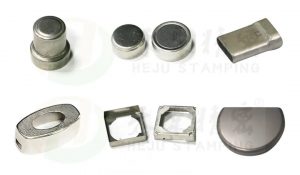Some Common Drawing Forming Processing Types
Drawing forming is a highly efficient stamping processing technique that utilizes a specialized mold to convert a flat blank into a hollow part. As a key stamping process, drawing is extensively employed in various industries. Its versatile capabilities allow the drawing to produce thin-walled parts of various shapes, including cylindrical, rectangular, spherical, and other irregular forms.
Use stamping equipment for drawing forming processing of products, including deep drawing processing, re-drawing processing, reverse drawing, thinning drawing processing, etc.
-
Flanged Hemispherical Drawing Processing
When the spherical part is drawing, the blank is partially in contact with the spherical top of the punch. And most of the rest is in an unconstrained free state. Therefore, the main process problem in drawingsuch spherical parts is the severe thinning of the local contact part or the instability and wrinkling of the curved surface part.
-
Panel Drawing Processing
Panel products are metal stamping parts with complex surface shapes. In the drawing process, the deformation of the blank is complex, and its forming property is no longer simple drawing forming but a composite forming in which drawing and bulging coexist.
-
Cylinder Drawing Processing
drawing of cylindrical products with flanges (flanges). The flange and the bottom are both flat, the side wall of the cylinder is axially symmetrical, the deformation is evenly distributed on the same circumference, and the blank on the flange produces deep drawing deformation.
-
Elliptical Drawing Processing
The flange blank undergoes drawing deformation, with the extent and proportion of the deformation varying following the contour shape. Specifically, the more pronounced the curvature, the greater the degree of plastic deformation experienced by the blank, and vice versa – less curvature translates to smaller plastic deformation.
-
Rectangular Drawing Processing
Low rectangular parts formed by one drawing. When drawing, the tensile resistance at the rounded corners of the flange deformation zone is greater than that at the straight edges. And the degree of deformation at the rounded corners is greater than that at the straight edges.
-
Deep Drawing Processing
To ensure completion, a drawing exceeding the processing limit must be redrawn multiple times, often more than twice. When drawing in the depth direction at the front station, products require additional redrawing in the same direction. For wide flange drawing parts, the required flange diameter is achieved on the first draw, and remains unchanged for subsequent redraws.
-
Reverse Drawing
Reverse drawing the workpiece drawing in the previous process, a type of re-drawing. The reverse drawing method can increase the radial tensile stress and achieve better results in preventing wrinkles. It is also possible to increase the drawing factor for re-drawing.
-
Thinning Drawing
Thinning drawing processes differ from traditional drawing methods. They focus on altering the thickness of the tube wall during the drawing process. This is achieved by passing the straight wall part of the blank through a gap between convex and concave molds that is smaller than the thickness of the blank itself. The result is a uniform compressive stress on the wall of the container, which becomes thinner during the process. This eliminates deviations in wall thickness and improves the smoothness, precision, and strength of the container’s surface.
In Conclusion
When it comes to the stamping process of drawn parts, it’s important to carefully evaluate potential suppliers. Begin by assessing their experience and technical expertise in this area, ensuring that their capabilities align with your product requirements.
An essential factor to keep in mind is determining the most suitable stamping process for your tensile parts that aligns with your product’s unique specifications. This may necessitate careful material selection, mold design, and strategic optimization of stamping process parameters, among other considerations. By pinpointing the perfect process solution, we can guarantee optimal production efficiency.

Hejustamping-Faithfully Micro Deep Draw Stamping Manufacturer
Dongguan Heju Precision Electronic Technology Co., Ltd. is a company specializing in the production of precision deep drawn parts. It has 30 years experience for small deep drawn enclosures widly used for e-cigarettes, micromotors, batteries, sensors, pacemakers, etc. It can achieve external R/ T<1.0; there is strict quality control and reporting from materials to production and processing to sales. At the same time, the development center is equipped with advanced computer simulation technology for drawing forming analysis and verification. It can customize production according to customer needs and requirements and provide optimal solutions!
